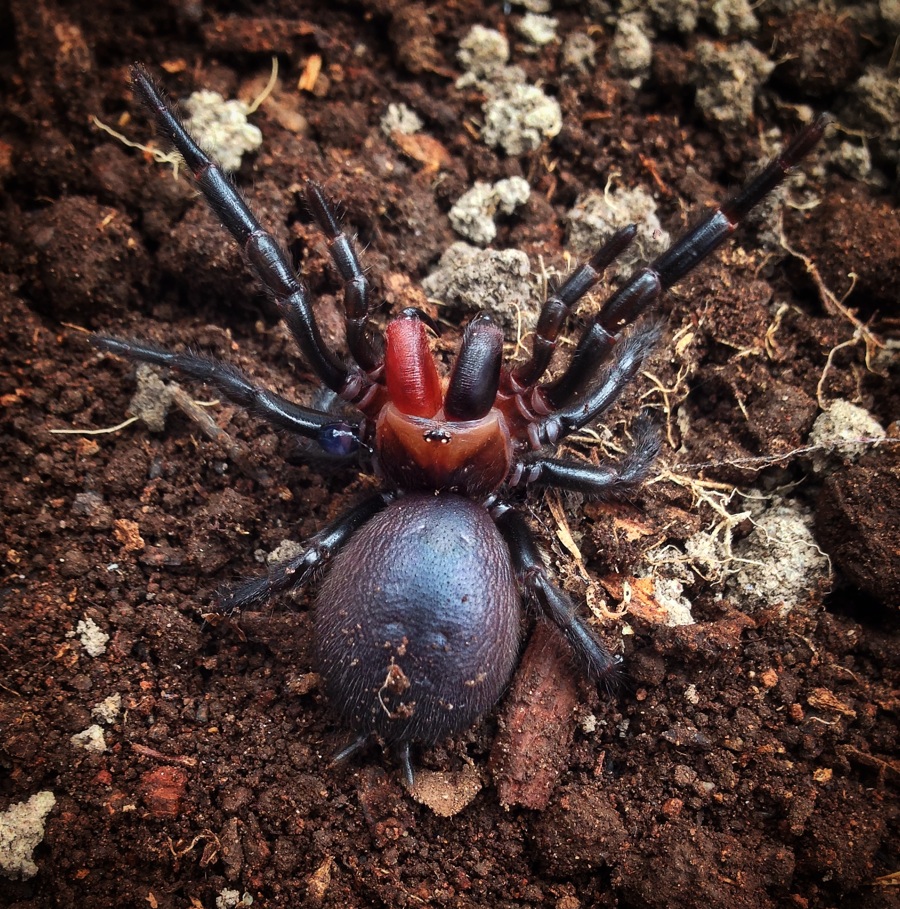An Arachnid Dracula? Rare, Red-Fanged Spider Is Uncovered

A one-of-a-kind spider from Down Under looks more like a Transylvania transplant than an Aussie, thanks to its red fangs.
The funnel-web spider (Atrax sutherlandi) does not actually vant to suck your blood, however. These shy spiders build their webs at the top of subterranean burrows and mostly eat insects. (Some species, though, do have venom dangerous to humans, and will defend themselves if they feel threatened. A. sutherlandi is venomous, but isn't known to have caused any fatalities in humans, according to the Australian Environmental Pest Management Association.)
As a species, A. sutherlandi has been known for a long time. But when Mark Wong, an ecologist at Australian National University and the winner of a National Geographic Young Explorer grant, uncovered this one under a piece of fallen wood, he met with a surprise. [See Photos of the Blood Red-Fanged Spider]
"Almost instantly, the spider had rushed out of her silken lair with her legs raised and fangs greeting me with glistening venom," Wong wrote in an email to Live Science. "Taken aback by her colors, I knew there and then this was something special."
Unusual find
In years of hunting and studying funnel-web spiders, Wong and his colleagues had never seen a "redhead." The spider has one bright red fang and patches of red on the rest of its head. [Watch the Red-Fanged Spider in Action: Video]
Other specimens do sometimes have red on different body parts, Wong said, so it's possible that in this spider, the genes for the red pigment are simply expressing themselves in the wrong places. Alternatively, all funnel-web spiders of this species might have genes for red-pigmented heads and fangs, but typically this color doesn't show up, because it's masked by more dominant black pigmentation.
Get the world’s most fascinating discoveries delivered straight to your inbox.
"Perhaps in this specimen, the genes for black pigments have not been expressed, thus revealing the red pigmentation underneath," Wong said.
Spider colors
Wong discovered the spider in Australia's Tallaganda State Forest, where he and his colleagues often do fieldwork and collect funnel-web spider specimens. It's a careful process: The researchers search for telltale webs of silk, typically shaped like a funnel, under logs and rocks and then use a probe to figure out the direction of the spider burrow. They then gently scrape away the dirt to find their quarry.
"As they are usually hiding deep underground (>25 centimeters) [10 inches], there's really no easy way to collect them, and it usually takes between 10 to 30 minutes just to retrieve one specimen!" Wong said. The spiders are about 2 inches (5 cm) long.
It's not possible to draw many conclusions from a single odd-colored specimen, Wong said, but the find is interesting because many spiders show color variation from individual to individual. The Hawaiian happy-face spider (Theridion grallator) changes color depending on its diet, he said, while some crab spiders come in different colors depending on their camouflage needs. And the brightly colored peacock spider (Maratus volans) can have lots of variation in its elaborate body decoration.
"Interestingly, the male red-headed mouse spider (Missulena occatoria), a spider distantly related to funnel-webs, also displays red colors and looks quite similar to this particular specimen," Wong said.
It's likely that the red-fanged funnel-web spider was underappreciated by her own kind. Funnel-web spiders have poor vision, probably because they spend all of their time in underground burrows, Wong said.
"As far as we know, only the males wander around, and we think they locate the females by pheromone cues, not visual searching," he said.
Follow Stephanie Pappas on Twitter and Google+. Follow us @livescience, Facebook & Google+. Original article on Live Science.

Stephanie Pappas is a contributing writer for Live Science, covering topics ranging from geoscience to archaeology to the human brain and behavior. She was previously a senior writer for Live Science but is now a freelancer based in Denver, Colorado, and regularly contributes to Scientific American and The Monitor, the monthly magazine of the American Psychological Association. Stephanie received a bachelor's degree in psychology from the University of South Carolina and a graduate certificate in science communication from the University of California, Santa Cruz.
